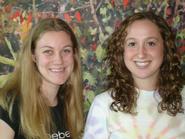
Kristin Alongi '08 (Chittenango, N.Y.) and Alexa Ashworth '09 (Pittsford, N.Y.) are working together on a summer research project in Winslow Professor of Chemistry George Shields's computational chemistry lab. Alongi, a returning member of Shields' lab, and Ashworth, new to summer research, are studying aerosol formation using advanced computer technology.
In the atmosphere, gases can do one of two things. They can absorb infrared light, which leads to global warming; or, they can cluster together to form aerosols, which reflect light and therefore contribute to global cooling. "We are trying to learn why aerosols form and how it happens," explained Alongi. An understanding of how and why aerosols form in the atmosphere could lead to more effective methods of combating global warming. There has not been a lot of research on aerosol formation and no one in Shields' lab has ever studied it using computational chemistry. "We are pioneering aerosol science," said Alongi.
Different gases combine with water in the atmosphere to form aerosol clusters. In particular, it has been hypothesized that H2SO4 (sulfuric acid) is a critical player in aerosol formation. Alongi and Ashworth input different systems into the computer and vary the number of water molecules and the geometry to see which ones produce the most favorable combination for aerosol formation. Most experimental work has been done in larger systems, but the computer programs allow them to look at much smaller systems. "We are trying to better understand aerosol formation at the molecular level and how H2SO4 affects that," said Alongi. "We are trying to find which computational model works the best," Ashworth added.
Because there is not a lot of research in this area, Alongi and Ashworth are facing some challenges in the onset of their research. Some of the calculations they need to use have never been done before and there is not a lot of guidance on where to start, so they must do lots of different trials. Still, they expect to work out the kinks and are optimistic about the research.
"I had been thinking about being a chemistry major and wanted to try lab work to see how I like it. I really like it so far," said Ashworth, who is also a member of Hamilton's Step Team as well as a student host for admissions, and plays the flute.
"I like working with the computers, and I'm considering [a career in] research so this is good experience," said Alongi, a chemistry major. Alongi is on the executive board of Hamilton's chapter of the Association of Women in Science and is a grader for introductory chemistry and math courses. Both students are working with Visiting Professor of Chemistry Karl Kirschner and Lab Instructor Chuck Borton, along with Professor Shields, and the five person team is also collaborating with scientists at the National Center for Atmospheric Research and the University of Colorado at Boulder.
-- by Laura Trubiano '07
Posted June 23, 2006
